Geochronology/Mesozoic
< Geochronology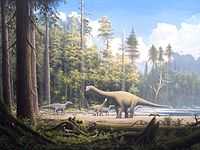
Geochronology/Mesozoic is the science of applying dates in the past to rocks of the Mesozoic.
Notations
Let
- ALMA represent the Asian Land Mammal Age,
- b2k represent before AD 2000,
- BP represent before present, as the chart is for 2008, this may require an added -8 for b2k,
- ELMMZ represent the European Land Mammal Mega Zone,
- FAD represent first appearance datum,
- FO represent first occurrence,
- Ga represent Gegaannum, billion years ago, or -109 b2k,
- GICC05 represent Greenland Ice Core Chronology 2005,
- GRIP represent Greenland Ice Core Project,
- GSSP represent Global Stratotype Section and Point,
- HO represent highest occurrence,
- ICS represent the International Commission on Stratigraphy,
- IUGS represent the International Union of Geological Sciences,
- LAD represent last appearance datum,
- LO represent lowest occurrence,
- Ma represent Megaannum, million years ago, or -106 b2k,
- NALMA represent the North American Land Mammal Age,
- NGRIP represent North Greenland Ice Core Project, and
- SALMA represent South American Land Mammal Age.
"The term b2 k [b2k] refers to the ice-core zero age of AD 2000; note that this is 50 years different from the zero yr for radiocarbon, which is AD 1950 [...]."[1]
Mesozoic time frames
| Name (English)[2] | base/start (Ma)[3] | top/end (Ma)[3] | status | subdivision of | usage | named after | author, year |
|---|---|---|---|---|---|---|---|
| Aalenian | 175.6 ± 2.0 | 171.6 ± 3.0 | age | Jurassic | ICS | Aalen (Germany) | |
| Aegean | 245 ± 1.5 | 244 | age | Middle Triassic | Europe | Aegean Sea | |
| Alaunian | 216 | 211 | sub-age | Upper Triassic | Europe | ||
| Albian | 112.0 ± 1.0 | 99.6 ± 0.9 | age | Cretaceous | ICS | Albia, Latin name of the river Aube (France) | d'Orbigny, 1842 |
| Anisian | 245.0 ± 1.5 | 237.0 ± 2.0? | age/Stage | Middle Triassic | ICS | Anisus, Latin name for the river Enns (Austria) | |
| Aptian | 125.0 ± 1.0 | 112.0 ± 1.0 | age | Cretaceous | ICS | Apt (France) | d'Orbigny, 1840 |
| Aquilan | 85.2 | 82.2 | NALMA | Cretaceous | North America | ||
| Arowhanan | 95.2 | 92.1 | age | Cretaceous | New Zealand | Arowhana | |
| Austinian | age | Cretaceous | south and east of the US | Austin, Texas | Murray, 1961 | ||
| Bajocian | 171.6 ± 3.0 | 167.7 ± 3.5 | age | Jurassic | ICS | Bayeux (France) | d'Orbigny |
| Barremian | 130.0 ± 1.5 | 125.0 ± 1.0 | age | Cretaceous | ICS | Barrême (France) | Coquand, 1873 |
| Bathonian | 167.7 ± 3.5 | 164.7 ± 4.0 | age | Jurassic | ICS | Bath (England) | |
| Bedoulian | 129.97 | 125.0 | sub-age | Cretaceous | regional | ||
| Berriasian | 145.5 ± 4.0 | 140.2 ± 3.0 | age | Cretaceous | ICS | Berrias (France) | |
| Bithynian | Substage | Middle Triassic | Germany | ||||
| Brahmanian | 252.6 | 251 | Stage | Lower Triassic | India, Germany | ||
| Buntsandstein[4] | 251.0 ± 0.4 | 246.6[5] | epoch/subperiod | Triassic | Europe | German: bunte Sandstein = coloured sandstone | Von Alberti, 1834 |
| Callovian | 164.7 ± 4.0 | 161.2 ± 4.0 | age | Jurassic | ICS | Kellaways (England) | d'Orbigny |
| Campanian | 83.5 ± 0.7 | 70.6 ± 0.6 | age | Cretaceous | ICS | Champagne (France) | Coquand, 1857 |
| Carixian | 189.6 ± 1.5 | sub-age | Jurassic | regional | |||
| Carnian | 228.0 ± 2.0 | 216.5 ± 2.0 | age | Late Triassic | ICS | Carnic Alps (Austria) | Mojsisovics, 1869 |
| Cenomanian | 99.6 ± 0.9 | 93.5 ± 0.8 | age | Cretaceous | ICS | Latin: Cenomanium = Le Mans (France) | d'Orbigny, 1847 |
| Clansayesian | 115.0 | 112.0 | sub-age | Cretaceous | |||
| Coniacian | 89.3 ± 1.0 | 85.8 ± 0.7 | age | Cretaceous | ICS | Cognac (France) | Coquand, 1857 |
| Cordevolian | 237 | ~236 | sub-age | Late Triassic | regional | ||
| Cretaceous | 145.5 ± 4.0 | 65.5 ± 0.3 | period | Mesozoic | ICS | Crete; Latin creta=chalk | d'Omalius d'Halloy, 1822 |
| Dienerian | 251.6 | 251 | Substage | Lower Triassic | |||
| Dogger[4] | 175.6 ± 2.0 | 161.2 ± 4.0 | epoch | Jurassic | Northern Europe | dogger=ironrich sediment type | |
| Domerian | 183.0 ± 1.5 | sub-age | Jurassic | regional | |||
| Eaglefordian | age | Cretaceous | Gulf and Atlantic coast of the US | Eagle Ford, Dallas, Texas | Murray, 1961 | ||
| Early Triassic | Triassic | ||||||
| Edmontonian | 80.8 | 70.7 | NALMA | Cretaceous | North America | ||
| Emscherian | 89.5 | 83.5 | age | Cretaceous | Germany | ||
| Fassanian | 237 ± 2.0? | 233? | sub-age/substage | Middle Triassic | Europe | ||
| Gallic | 130.0 ± 1.5 | 89.3 ± 1.0 | epoch | Cretaceous | obsolete | ||
| Gandarian | 251.6 | 251 | Substage | Lower Triassic | India, Germany | ||
| Gangetian | 252.6 | 251.6 | Substage | Lower Triassic | India, Germany | ||
| Gargasian | 121.0 | 115.0 | sub-age | Cretaceous | regional | ||
| Gaultian | sub-age | Cretaceous | regional | ||||
| Gulf(-ian) | epoch | Cretaceous | south and east of the US | the Mexican Gulf | |||
| Haumurian | 84 | 65.5 | age | Cretaceous | New Zealand | ||
| Hauterivian | 136.4 ± 2.0 | 130.0 ± 1.5 | age | Cretaceous | ICS | Hauterive (Switzerland) | Renevier, 1873 |
| Hettangian | 199.6 ± 0.6 | 196.5 ± 1.0 | age | Jurassic | ICS | Hettange-Grande (France) | Renevier, 1864 |
| Houldjinian | 37.2 | 33.9 | ALMA | Asia | |||
| Illyrian | 240 ± 2.0 | 237 ± 2.0? | sub-age/Substage | Middle Triassic | Europe | ||
| Induan | 251.0 ± 0.4 | 249.7 ± 0.7 | age | Triassic | ICS | river Indus | Kiparisova & Popov, 1956 |
| Judithian | 82.2 | 80.8 | NALMA | Cretaceous | North America | ||
| Julian | 229.6 ± 2.0 | 222.5 | sub-age | Late Triassic | Europe | ||
| Jurassic | 199.6 ± 0.6 | 145.5 ± 4.0 | period | Mesozoic | ICS | Jura mountains | Brongniart |
| Karoo Ice Age | ~360 | ~260 | ice age | Phanerozoic | Karoo (South Africa) | ||
| Kekeamuan | 28.4 | 33.9 | ALMA | Asia | |||
| Keuper[4] | ±230 | 199.6 | epoch | Triassic | Europe | Von Alberti, 1834 | |
| Kimmeridgian | 155.7 ± 4.0 | 150.8 ± 4.0 | age | Jurassic | ICS | Kimmeridge (England) | d'Orbigny |
| Korangan | 117.5 | 108.4 | age | Cretaceous | New Zealand | ||
| Lacian | 217.4 ± 2.0 | 211 | sub-age | Upper Triassic | Europe | ||
| Ladinian | 237.0 ± 2.0 | 228.0 ± 2.0 | age | Middle Triassic | ICS | Ladini, people in northern Italy | Bittner, 1892 |
| Lancian | 70.7 | 65.5 | NALMA | Cretaceous | North America | ||
| Late Triassic | 237 | age | Triassic | Germany | |||
| Lias[4] | 199.6 ± 0.6 | 175.6 ± 2.0 | epoch | Jurassic | Northern Europe | unclear | |
| Longobardian | 233? | 229.6 ± 2.0? | sub-age/substage | Middle Triassic | Europe | ||
| Lotharingian | 193.3 ± 0.7 | 189.6 ± 0.7 | substage | Jurassic | |||
| Lower Triassic | 247 | 252.6 | Triassic | Germany | |||
| Maastrichtian | 70.6 ± 0.6 | 65.5 ± 0.3 | age | Cretaceous | ICS | Maastricht (Netherlands) | Dumont, 1849 |
| Malm[4] | 161.2 ± 4.0 | 145.5 ± 4.0 | epoch | Jurassic | Europe | Old English: malm = calcareous soil | |
| Mangaotanean | 92.1 | 89.1 | age | Cretaceous | New Zealand | ||
| Mesozoic | 251.0 ± 0.7 | 65.5 ± 0.3 | era | ICS | middle life | ||
| Middle Triassic | 247 | 237 | age | Triassic | Germany | ||
| Motuan | 103.3 | 100.2 | age | Cretaceous | New Zealand | ||
| Muschelkalk[4] | 243 ± 2 | 235 ± 2 | epoch | Triassic | Europe | German: limestone with mussels | Füchsel, 1761 |
| Navarroan | age | Cretaceous-Paleocene | south and east of the US | Navarro, Texas | Murray, 1961 | ||
| Neocomian | 145.5 | 125.0/130.0 | epoch | obsolete | Neocomium, Latin name for Neuchâtel | ||
| Ngaterian | 100.2 | 95.2 | age | Cretaceous | New Zealand | ||
| Norian | 216.5 ± 2.0 | 203.6 ± 1.5 | age | Upper Triassic | ICS | Noric Alps (Austria) | |
| Olenekian | 249.5 | 245.9 | age | Triassic | ICS | river Olenyok (Siberia) | |
| Oxfordian | 161.2 ± 4.0 | 155.0 ± 4.0 | age | Jurassic | ICS | Oxford (England) | d’Orbigny |
| Paleozoic | 542.0 ± 1.0 | 251.0 ± 0.7 | era | Phanerozoic | ICS | old life | |
| Pelsonian | Substage | Middle Triassic | Germany | ||||
| Phanerozoic | 542.0 ± 1.0 | present | eon | ICS | visible life | ||
| Piripauan | 86.5 | 84 | age | Cretaceous | New Zealand | ||
| Pliensbachian | 189.6 ± 1.5 | 183.0 ± 1.5 | age | Jurassic | ICS | Pliensbach (Germany) | Oppel, 1858 |
| Portlandian | age | Jurassic | British Isles | Isle of Portland (England) | |||
| Puercan | 65.5 | 63.3 | age | Paleocene-Cretaceous | North America | ||
| Purbeckian | age | Cretaceous-Jurassic | England (obsolete) | Isle of Purbeck (England) | |||
| Rhaetian | 203.6 ± 1.5 | 199.6 ± 0.6 | age | Triassic | ICS | Rhaetian Alps (Switzerland, Austria, Italy) | |
| Santonian | 85.8 ± 0.7 | 83.5 ± 0.7 | age | Cretaceous | ICS | Saintes (France) | Coquand, 1873 |
| Scythian | 251 ± 0.2 | 245 ± 1.5 | Epoch | Early Triassic | Europe | Scythia | |
| Senonian | 89.3 | 65.5 | epoch | Cretaceous | unofficial | Sens (France) | d'Orbigny |
| Sevatian | 206 | 202.3 ± 1.5 | sub-age | Upper Triassic | Europe | ||
| Sinemurian | 196.5 ± 1.0 | 189.6 ± 1.5 | age | Jurassic | ICS | Semur-en-Auxois (France) | d'Orbigny, 1842 |
| Smithian | 251 | 249 | Substage | Lower Triassic | Germany | ||
| Spathian | 249 | 247 | Substage | Lower Triassic | Germany | ||
| Tayloran | age | Cretaceous | south and west of the US | Taylor, Texas | Murray, 1961 | ||
| Teratan | 89.1 | 86.5 | age | Cretaceous | New Zealand | ||
| Tithonian | 150.8 ± 4.0 | 145.5 ± 4.0 | age | Jurassic | ICS | Tithon (Greek mythology) | Oppel, 1865 |
| Toarcian | 183.0 ± 1.5 | 175.6 ± 2.0 | age | Jurassic | ICS | Thouars (France) | d'Orbigny, 1849 |
| Triassic | 251.0 ± 0.4 | 199.6 ± 0.6 | period | Mesozoic | ICS | threefold | Von Alberti, 1834 |
| Turonian | 93.5 ± 0.8 | 89.3 ± 1.0 | age | Cretaceous | ICS | Tours (France) | d'Orbigny, 1842 |
| Tuvalian | 222.5 | 217.4 ± 2.0 | sub-age | Upper Triassic | Europe | ||
| Upper Triassic | 199.6 | age | Triassic | Germany | |||
| Urutawan | 108.4 | 103.3 | age | Cretaceous | New Zealand | ||
| Valanginian | 140.2 ± 3.0 | 136.4 ± 2.0 | age | Cretaceous | ICS | Valangin (Switzerland) | Desor, 1853 |
| Vraconian | sub-age | Cretaceous | regional | ||||
| Woodbinian | age | Cretaceous | Gulf and Atlantic coast of the US | Murray, 1961 |
Cretaceous
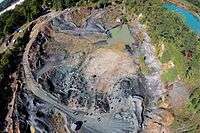
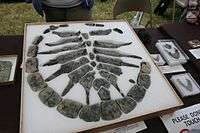
"Paleogeographically, the sub-alpine terrain of southeastern France [...] was located on the proximal part of the South-European Tethys margin. It includes the Vocontian Basin, which experienced relatively high rates of subsidence during Jurassic and Early Cretaceous times, bordered by carbonate platforms limited by a net of extensional or strike–slip faults (Graciansky et al., 1999)."[6]
This phraseology connects "Early Cretaceous" with "times".
The aerial image on the right shows the quarry pit in Mantua Township in central New Jersey has been owned by the Inversand Company for nearly a century.[7]
"When an asteroid hit the Earth around 66 million years ago, it wiped out almost 75 percent of the plants and animals on the planet. All dinosaurs, except those that would eventually give rise to modern birds, were killed following the impact. Yet despite such a vast die-off, no bone bed containing a concentration of fossils as a result of this event has been found."[7]
“We don’t know yet [if it dates from the mass extinction], but we are testing this hypothesis by examining the fossils, the sediments and the chemistry.”[8]
"At the end of the Cretaceous, when the dinosaurs met their maker, the region was a shallow tropical sea full of fish, sea turtles, crocodiles, and even mosasaurs. But at some point around 66 million years ago, whether it was due to the asteroid impact or some other cause, many of the inhabitants of the sea died and were preserved in a large bone bed."[7]
On the left is a specimen of Catapleura repanda from the Rowan quarry found in the Cretaceous marl.
Late Jurassic
Paleontologists appear to prefer "Late Jurassic", "Middle Jurassic", and "Early Jurassic".[9]
Time frame references such as "We applied the method of frequency ratios (Huang et al., 1992; Mayer and Appel, 1999) to compare the observed spectral frequencies with orbital frequencies estimated for Late Jurassic time (Berger and Loutre, 1994) (Tables 1A and B)."[6] use "Late Jurassic" as a time frame, but "Upper Jurassic" as a stratigraphic frame.
Upper Jurassic
The International Commission on Stratigraphy (ICS) uses only "Upper Jurassic", "Middle Jurassic", and "Lower Jurassic" in its Global Boundary Stratotype Section and Point (GSSP) Table for all periods.[10]
Aalenian


"The Global Boundary Stratotype Section and Point (GSSP) for the Aalenian Stage, formally defined at the base of bed FZ107 in the Fuentelsaz section, Castilian Branch of the Iberian Range (Spain), has been ratified by the IUGS."[11]
"The position of the boundary coincides with the first occurrence of the ammonite assemblage characterized by Leioceras opalinum and Leioceras lineatum and corresponds with a normal polarity interval correlated with the up-to-date Jurassic magnetic polarity time scale (Gradstein and others, 1994; Ogg, 1995)."[11]
The "first occurrence of the species of the genus Leioceras, evolved from Pleydellia, has been widely accepted as being the biochronological event which best enables the recognition of the basal boundary of the Aalenian Stage."[11]
On the right is a chart which indicates the ammonite zones that serve as geochrons for the Aalenian.
The second image down on the right displays the type strata for the Aalenian.
An example of Leioceras opalinum is shown on the left.
Hettangian
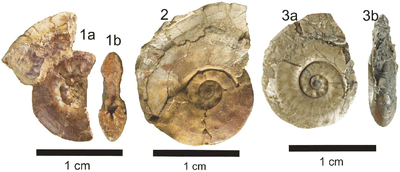
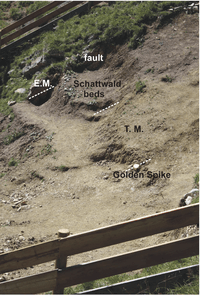
"Since the 1960’s, the LO (lowest occurrence) of the ammonite Psiloceras (usually the species P. planorbis [first image on the right]) has provided the working definition of the TJB (e.g., Lloyd, 1964; Maubeuge, 1964; Cope et al., 1980; Warrington et al., 1994; Gradstein et al., 2004)."[12]
"The Global Stratotype Section and Point (GSSP) defining the base of the Jurassic System Lower Jurassic Epoch and Hettangian Stage is situated at the Kuhjoch pass, Karwendel Mountains, Northern Calcareous Alps, Austria (47°29'02"N/11°31'50"E). The Triassic-Jurassic (T-J) boundary is exposed at Kuhjoch West and at Kuhjoch East [in the second image on the right], and corresponds to the first occurrence (FO) of the ammonite Psiloceras spelae tirolicum [at the top of this section]."[13]
Another FO is that of "the aragonitic foraminifer Praegubkinella turgescens"[13]
Triassic
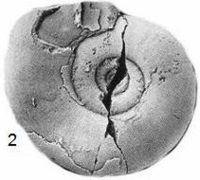
"What must underlie discussion of the definition of the TJB is the well accepted concept that global correlateability should be the main emphasis in the selection of a GSSP (e.g., Cowie et al., 1986; Remane et al., 1996; Gradstein et al., 2004; Walsh et al., 2004). As Remane et al. (1996: 79) expressed it, “the boundary definition will normally start from the identification of a level which can be characterised by a marker event of optimal correlation potential.” Thus, our goal here is to evaluate the possible marker events that could be used to define the TJB and to argue that an ammonite-based marker event has optimal correlation potential. This marker event is the LO of Psiloceras tilmanni in the New York Canyon section of Nevada."[12]
Upper Triassic
The chart in the Norian section describes the chronology of Upper Triassic time frames.
Rhaetian
The "extinction of Conodonta has long been seen as a terminal Triassic event, and the presence/absence of conodonts thus is routinely used to distinguish Triassic from Jurassic strata. Rhaetian conodont assemblages are of low diversity and abundance, and conodonts can be easily reworked. Therefore, the HO of Conodonta is not a reliable criterion for TJB definition. However, it is very useful to know that the presence of autochthonous Conodonta is a pre-Jurassic indicator, and this micropaleontological criterion has been widely used and accepted."[12]
Norian
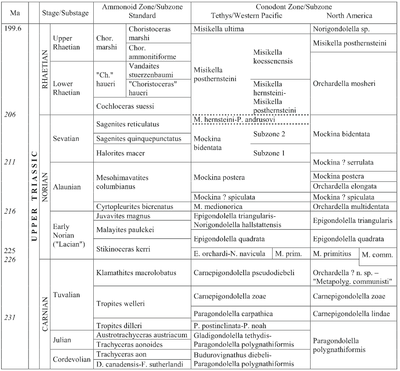
The chart above shows the chronological positions of Upper Triassic Stages and Substages, including the Norian.
Sevatian
The chart in the Norian section describes the chronology of Upper Triassic time frames, including the Sevatian.
Alaunian
The chart in the Norian section describes the chronology of Upper Triassic time frames, including the Alaunian.
Lacian
The chart in the Norian section describes the chronology of Upper Triassic time frames, including the Lacian or Early Norian.
Carnian
The chart in the Anisian section places the Carnian in the Late, or Upper, Triassic.
Tuvalian
The chart in the Norian section describes the chronology of Upper Triassic time frames, including the Tuvalian.
Julian
The chart in the Anisian section places the Julian in the Carnian.
Cordevolian
The chart in the Anisian section places the Cordevolian in the Carnian.
Middle Triassic
The chart in the Anisian section places the Middle Triassic below the Late Triassic.
Ladinian
The chart in the Anisian section places the Ladinian above the Asinian.
Longobardian
The chart in the Anisian section places the Longobardian above the Fassanian.
Fassanian
The chart in the Anisian section places the Fassanian at the base of the Ladinian.
Anisian
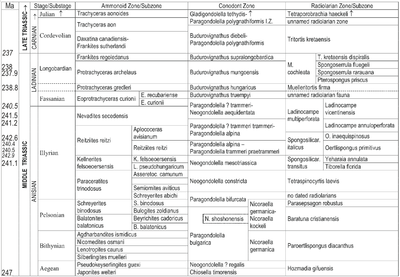
The chart above indicates the time frames at and above the Anisian.
Illyrian
The chart in the Anisian section places the Illyrian at the top of the Anisian.
Pelsonian
The chart in the Anisian section places the Pelsonian below the Illyrian.
Bithynian
The chart in the Anisian section places the Bithynian below the Pelsonian.
Aegean
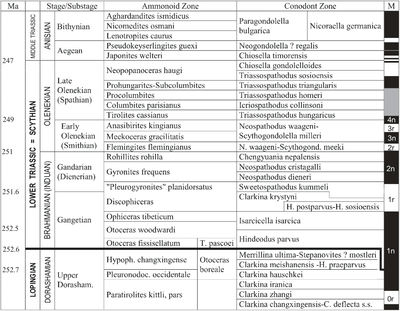
The chart above shows the Aegean as the lowest time frame of the Anisian.
The magnetostratigraphy in the farthest right column of the above chart has black as normal polarity, white as reversed polarity, and gray for no reliable data.
Lower Triassic
The chart in the Aegean section shows the Scythian to be equivalent to the Lower Triassic.
Scythian
The chart in the Aegean section shows the Scythian to be equivalent to the Lower Triassic.
Olenekian
The chart in the Aegean section indicates that the Scythian is divided into the Olenekian above and Induan below.
Spathian
The Spathian is sometimes referred to as the Late Olenekian.[14]
Smithian
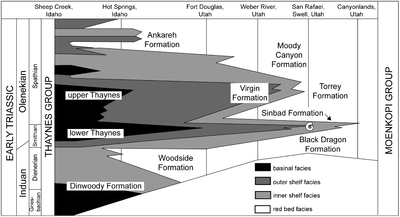
As indicated in the above stratigraphy, the Sinbad Formation is entirely within the Smithian, or Early Olenekian.
The Smithian is sometimes referred to as the Early Olenekian.[14]
Brahmanian
The chart in the Aegean section indicates that the Brahmanian is equivalent to the Induan.
Induan
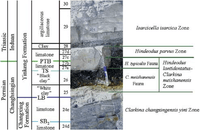
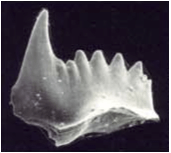
In the diagram on the right, the Permian-Triassic boundary is at the base of the Induan limestone that occurs within the Yinkeng Formation.
"The Global Stratotype Section and Point (GSSP) of the Permian-Triassic boundary [...] is defined at the base of Hindeodus parvus horizon, i.e. the base of Bed 27c of Meishan section D, Changxing County, Zhejiang Province, South China."[15]
"Hindeodus parvus is now recognized as the index fossil" occurring in the Zone above the P-T boundary.[15]
Dienerian
The chart in the Aegean section indicates that the Dienerian is equivalent to the Gandarian.
Gandarian
The chart in the Aegean section indicates that the Gandarian is in the Brahmanian.
Gangetian
The chart in the Aegean section indicates that the Gangetian is in the Brahmanian.
Locations on Earth
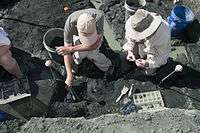
At the Inversand quarry, "Located in South Jersey, the cradle of dinosaur paleontology, the quarry in Mantua Township, N.J., contains thousands of fossils dating back 65 million years."[16]
Research
Hypothesis:
- Each time frame or span of time in geochronology has at least one dating technique.
- Late Jurassic and Upper Jurassic are different time frames.
Control groups

The findings demonstrate a statistically systematic change from the status quo or the control group.
“In the design of experiments, treatments [or special properties or characteristics] are applied to [or observed in] experimental units in the treatment group(s).[17] In comparative experiments, members of the complementary group, the control group, receive either no treatment or a standard treatment.[18]"[19]
Proof of concept
Def. a “short and/or incomplete realization of a certain method or idea to demonstrate its feasibility"[20] is called a proof of concept.
Def. evidence that demonstrates that a concept is possible is called proof of concept.
The proof-of-concept structure consists of
- background,
- procedures,
- findings, and
- interpretation.[21]
See also
References
- ↑ Mike Walker, Sigfus Johnsen, Sune Olander Rasmussen, Trevor Popp, Jørgen-Peder Steffensen, Phil Gibbard, Wim Hoek, John Lowe, John Andrews, Svante Björck, Les C. Cwynar, Konrad Hughen, Peter Kershaw, Bernd Kromer, Thomas Litt, David J. Lowe, Takeshi Nakagawa, Rewi Newnham and Jakob Schwander (2009). "Formal definition and dating of the GSSP (Global Stratotype Section and Point) for the base of the Holocene using the Greenland NGRIP ice core, and selected auxiliary records". Journal of Quaternary Science 24 (1): 3-17. doi:10.1002/jqs.1227. http://www.stratigraphy.org/GSSP/Holocene.pdf. Retrieved 2015-01-18.
- ↑ Names from local versions of the geologic timescale can often be found in the local language. The English name is usually found by replacing the suffix in the local language for -an or -ian. Examples for "local" suffices are -en (French), -ano (Spanish), -ium (German), -aidd (Welsh) or -aan (Flemish Dutch). The English name "Norian", for example, becomes Noriano in Spanish, Norium in German, Noraidd in Welsh or Norien in French.
- 1 2 Time is given in Megaannum (million years BP, unless other units are given in the table. BP stands for "years before present". For ICS-units the absolute ages are taken from Gradstein et al. (2004).
- 1 2 3 4 5 6 This name is often still used in a chronostratigraphic or geochronologic sense, although it is now officially a lithostratigraphic unit.
- ↑ Menning et al. 2005
- 1 2 Slah Boulila, Bruno Galbrun, Linda A. Hinnov, Pierre-Yves Collin (January 2008). "High-resolution cyclostratigraphic analysis from magnetic susceptibility in a Lower Kimmeridgian (Upper Jurassic) marl–limestone succession (La Méouge, Vocontian Basin, France)". Sedimentary Geology 203 (1-2): 54-63. http://www.sciencedirect.com/science/article/pii/S0037073807002928. Retrieved 2015-01-27.
- 1 2 3 Josh L Davis (12 January 2016). "Paleontologists Believe They Have Discovered The First Fossil Bed From The Dinosaur Extinction Event Itself". iflscience. Retrieved 2016-01-16.
- ↑ Kenneth Lacovara (12 January 2016). "Paleontologists Believe They Have Discovered The First Fossil Bed From The Dinosaur Extinction Event Itself". iflscience. Retrieved 2016-01-16.
- ↑ Guillermo W. Rougier, John R. Wible, and James A. Hopson (22 November 1996). "Basicranial Anatomy of Priacodon fruitaensis (Triconodontidae, Mammalia) from the Late Jurassic of Colorado, and a Reappraisal of Mammaliaform Interrelationships". Novitates (3183): 38. http://digitallibrary.amnh.org/dspace/handle/2246/3639. Retrieved 2015-01-27.
- ↑ International Commission on Stratigraphy (27 January 2015). "GSSP Table - All Periods". ICS. Retrieved 2015-01-27.
- 1 2 3 S. Cresta, A. Goy, S. Ureta, C. Arias, E. Barrón, J. Bernad, M. L. Canales, F. García-Joral, E. García-Romero, P. R. Gialanella, J. J. Gómez, J. A. González, C. Herrero, G. Martínez, M. L. Osete, N. Perilli and J. J. Villalaín (September 2001). "The Global Boundary Stratotype Section and Point (GSSP) of the Toarcian-Aalenian Boundary (Lower-Middle Jurassic)". Episodes 24 (3): 166-75. http://eprints.ucm.es/16664/1/file18.pdf. Retrieved 2015-01-15.
- 1 2 3 Spencer G. Lucas, Jean Guex, Lawrence H. Tanner, David Taylor, Wolfram M. Kuerschner Viorel Atudorei and Annachiara Bartolini (April 2005). "Definition of the Triassic-Jurassic boundary". Albertiana 32 (4): 12-35. http://paleo.cortland.edu/Albertiana/issues/Albertiana_32.pdf#page=21. Retrieved 2015-01-21.
- 1 2 A V Hillebrandt, L Krystyn, W M Kürschner, N R Bonis, M Ruhl, S Richoz, M A N Schobben, M Urlichs, P R Bown, K Kment, C A McRoberts, M Simms, and A Tomãsových (September 2013). "The Global Stratotype Sections and Point (GSSP) for the base of the Jurassic System at Kuhjoch (Karwendel Mountains, Northern Calcareous Alps, Tyrol, Austria)". Episodes 36 (3): 162-98. http://www.stratigraphy.org/GSSP/Hettangian.pdf. Retrieved 2015-01-21.
- 1 2 Heinz W. Kozur & Gerhard H. Bachmann (April 2005). "Correlation of the Germanic Triassic with the international scale". Albertiana 32 (4): 21-35. http://paleo.cortland.edu/Albertiana/issues/Albertiana_32.pdf#page=21. Retrieved 2015-01-23.
- 1 2 Yin Hongfu, Zhang Kexin, Tong Jinnan, Yang Zunyi and Wu Shunbao (June 2001). [http://www.stratigraphy.org/GSSP/Induan.pdf "The Global Stratotype Section and Point (GSSP) of the Permian-Triassic Boundary"]. Episodes 24 (2): 102-14. http://www.stratigraphy.org/GSSP/Induan.pdf. Retrieved 2015-01-20.
- ↑ Michelle Bruner (January 2016). "The Rowan University Fossil Quarry". Mantua Township, N.J.: Rowan University. Retrieved 2016-01-18.
- ↑ Klaus Hinkelmann, Oscar Kempthorne (2008). Design and Analysis of Experiments, Volume I: Introduction to Experimental Design (2nd ed.). Wiley. ISBN 978-0-471-72756-9. http://books.google.com/?id=T3wWj2kVYZgC&printsec=frontcover.
- ↑ R. A. Bailey (2008). Design of comparative experiments. Cambridge University Press. ISBN 978-0-521-68357-9. http://www.cambridge.org/uk/catalogue/catalogue.asp?isbn=9780521683579.
- ↑ "Treatment and control groups, In: Wikipedia". San Francisco, California: Wikimedia Foundation, Inc. May 18, 2012. Retrieved 2012-05-31.
- ↑ "proof of concept, In: Wiktionary". San Francisco, California: Wikimedia Foundation, Inc. November 10, 2012. Retrieved 2013-01-13.
- ↑ Ginger Lehrman and Ian B Hogue, Sarah Palmer, Cheryl Jennings, Celsa A Spina, Ann Wiegand, Alan L Landay, Robert W Coombs, Douglas D Richman, John W Mellors, John M Coffin, Ronald J Bosch, David M Margolis (August 13, 2005). "Depletion of latent HIV-1 infection in vivo: a proof-of-concept study". Lancet 366 (9485): 549-55. doi:10.1016/S0140-6736(05)67098-5. http://www.ncbi.nlm.nih.gov/pmc/articles/PMC1894952/. Retrieved 2012-05-09.
External links
- The Denisens of Cretaceous Mantua
- Global Boundary Stratotype Section and Point (GSSP) of the International Commission on Stratigraphy
| |||||||||||||||||||||||||||||||||||
![]() This is a research project at http://en.wikiversity.org
This is a research project at http://en.wikiversity.org
| |
Development status: this resource is experimental in nature. |
| |
Resource type: this resource is an article. |
| |
Resource type: this resource contains a lecture or lecture notes. |
| |
Subject classification: this is a Geology resource. |